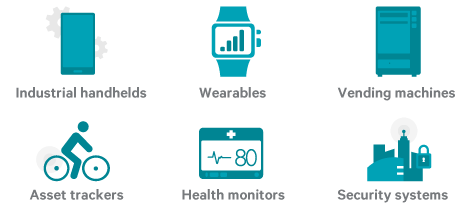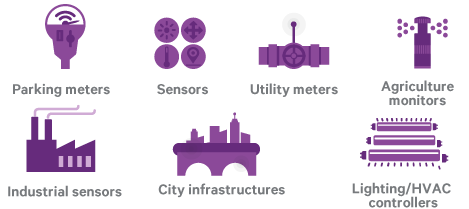CableFree IoT – The Internet of Things

The IoT (Internet of Things) is the network of physical devices, vehicles, home appliances and other items embedded with electronics, software, sensors, actuators, and network connectivity which enables these objects to connect and exchange data. Each thing is uniquely identifiable through its embedded computing system but is able to inter-operate within the existing Internet infrastructure.
Experts estimate that the Internet of Things will consist of about 30 billion objects by 2020. It is also estimated that the global market value of Internet of Things will reach $7.1 trillion by 2020
The CableFree product range is ideal to implement and connect an Internet of Things network using either 4G/LTE or WiFi solutions to connect IoT devices:
- Cellular Wide Area Network: CableFree LTE using NB-IoT
- Closed/Private Network: CableFree WiFi
Cellular Internet of Things using NB-IoT and LTE-M
LTE Internet of Things is a suite of two complementary narrowband technologies – eMTC1 & NB-IoT2 – defined starting in 3GPP Release 13. Together, they deliver optimized performance and efficiency for a wide range of low-power, wide-area Internet of Things

CableFree LTE Supports Internet of Things
CableFree 4G LTE base stations support NB-IoT release 13, release 14 and 15 compliant standards, to enable connection of Internet of Things devices to a CableFree LTE base station.
- Single-tone and multi-tone category NB1 UE support
- 15 kHz and 3.75 kHz subcarrier spacing are supported
- All operation modes (in-band, guard band and standalone) are supported
- Multiple NB-IoT and LTE cells can be used at the same time in the same eNodeB

NB-IoT
NB-IoT is a narrowband radio technology designed for the Internet of Things and is one of a range of Mobile (MIoT) technologies standardized by the 3rd Generation Partnership Project (3GPP). This standard focuses specifically on indoor coverage, low cost, long battery life, and enabling a large number of connected devices. The NB-IoT technology is deployed “in-band” in spectrum allocated to Long Term Evolution (LTE), using resource blocks within a normal LTE carrier (or in the unused resource blocks within a LTE carrier’s guard-band) or “standalone” for deployments in dedicated spectrum. It is also suitable for the re-farming of GSM spectrum.
LTE-M
LTE-M (LTE-MTC Machine Type Communication) includes eMTC (enhanced Machine Type Communication), is a type of low power wide area network (LPWAN) radio technology standard developed by 3GPP to enable a wide range of cellular devices and services (specifically, for machine-to-machine and Internet of Things applications). The specification for eMTC (LTE Cat-M1) was frozen in 3GPP Release 13 (LTE Advanced Pro), in June 2016. Other 3GPP IoT technologies include NB-IoT and EC-GSM-IoT.
The advantage of LTE-M over NB-IoT is its comparatively higher data rate, mobility, and voice over the network, but it requires more bandwidth, is more costly, and cannot be put into guard band frequency band for now.. In March 2019, the Global Mobile Suppliers Association reported that over 100 operators had deployed/launched either NB-IoT or LTE-M networks.
LTE-M and NB-IoT standards compared
|
|
LTE Cat 1 | LTE-M | NB-IoT | EC-GSM-IoT | ||||
|---|---|---|---|---|---|---|---|---|
| LC-LTE/MTCe | eMTC | |||||||
| LTE Cat 0 | LTE Cat M1 | LTE Cat M2 | non-BL | LTE Cat NB1 | LTE Cat NB2 | |||
| 3GPP Release | Release 8 | Release 12 | Release 13 | Release 14 | Release 14 | Release 13 | Release 14 | Release 13 |
| Downlink Peak Rate | 10 Mbit/s | 1 Mbit/s | 1 Mbit/s | ~4 Mbit/s | ~4 Mbit/s | 26 kbit/s | 127 kbit/s | 474 kbit/s (EDGE)
2 Mbit/s (EGPRS2B) |
| Uplink Peak Rate | 5 Mbit/s | 1 Mbit/s | 1 Mbit/s | ~7 Mbit/s | ~7 Mbit/s | 66 kbit/s (multi-tone)
16,9 kbit/s (single-tone) |
159 kbit/s | 474 kbit/s (EDGE)
2 Mbit/s (EGPRS2B) |
| Latency | 50–100ms | not deployed | 10ms–15ms | 1.6s–10s | 700ms–2s | |||
| Number of Antennas | 2 | 1 | 1 | 1 | 1 | 1 | 1 | 1–2 |
| Duplex Mode | Full Duplex | Full or Half Duplex | Full or Half Duplex | Full or Half Duplex | Full or Half Duplex | Half Duplex | Half Duplex | Half Duplex |
| Device Receive Bandwidth | 1.4 – 20 MHz | 1.4 – 20 MHz | 1.4 MHz | 5 MHz | 5 MHz | 180 kHz | 180 kHz | 200 kHz |
| Receiver Chains | 2 (MIMO) | 1 (SISO) | 1 (SISO) | 1 (SISO) | 1 (SISO) | 1 (SISO) | 1 (SISO) | 1–2 |
| Device Transmit Power | 23 dBm | 23 dBm | 20 / 23 dBm | 20 / 23 dBm | 20 / 23 dBm | 20 / 23 dBm | 14 / 20 / 23 dBm | 23 / 33 dBm |
NB-IoT Frequency Bands (As per 3GPP Rel. 13, 14 and 15)
The 3GPP has defined a set of frequency bands for which NB-IoT can be used. 3GPP TS 36.101 from Release 13 provides the list of the supported bands: 1, 2, 3, 5, 8, 12, 13, 17, 18, 19, 20, 26, 28, 66 and Release 14 added the bands: 11, 25, 31 and 70. Later, 3GPP Release 15 added further bands: 4, 14, 71, 72, 73, 74 and 85. For Narrow Band IoT system operates in HD-FDD duplex mode.
NB-IoT Forum members, so far, indicates a variety of bands have been used. Below is an overview of the frequency bands supported in the different regions:
- North America: B4 (1700), B12 (700), B66 (1700), B71 (600), B26 (850)
- Asia Pacific: B1(2100), B3(1800), B5(850), B8(900), B18(850), B20(800), B26(850)
and B28(700); - Europe: B3 (1800), B8 (900) and B20 (800);
- Latin America: B2(1900), B3(1800), B5(850) and B28(700)
- Commonwealth of Independent States: B3 (1800), B8 (900) and B20 (800);
- Sub-Saharan Africa: B3(1800) and B8(900);
- Middle East and North Africa: B8(900) and B20(800);
These bands are only a subset of the bands supported by 3GPP Release 13 are likely to be used: a total of thirteen frequency bands (1, 2, 3, 4, 5, 8, 12, 18, 20, 26, 28, 66 and 71). After looking at the minimum overlap of the bands for individual countries, a minimum of ten bands: 1, 2, 3, 4, 5, 8, 12, 20, 26 and 28 are required for coverage in all the countries for which the NB-IoT forum members have suggested.
3GPP Release 13 NB IoT Frequency Band Details :
| NB Band | Uplink (UL) Operating Band BS Receive / UE Transmit FUL_low – FUL_high |
Downlink (DL) Operating Band BS Transmit / UE Receive FDL_low – FDL_high |
Duplex Mode |
| B1 | 1920 MHz – 1980 MHz | 2110 MHz – 2170 MHz | HD-FDD |
| B2 | 1850 MHz – 1910 MHz | 1930 MHz – 1990 MHz | HD-FDD |
| B3 | 1710 MHz – 1785 MHz | 1805 MHz – 1880 MHz | HD-FDD |
| B5 | 824 MHz – 849 MHz | 869 MHz – 894 MHz | HD-FDD |
| B8 | 880 MHz – 915 MHz | 925 MHz – 960 MHz | HD-FDD |
| B12 | 699 MHz – 716 MHz | 729 MHz – 746 MHz | HD-FDD |
| B13 | 777 MHz – 787 MHz | 746 MHz – 756 MHz | HD-FDD |
| B17 | 704 MHz – 716 MHz | 734 MHz – 746 MHz | HD-FDD |
| B18 | 815 MHz – 830 MHz | 860 MHz -875 MHz | HD-FDD |
| B19 | 830 MHz – 845 MHz | 875 MHz – 890 MHz | HD-FDD |
| B20 | 832 MHz – 862 MHz | 791 MHz -821 MHz | HD-FDD |
| B26 | 814 MHz – 849 MHz | 859 MHz – 894 MHz | HD-FDD |
| B28 | 703 MHz – 748 MHz | 758 MHz – 803 MHz | HD-FDD |
| B66 | 1710 MHz – 1780 MHz | 2110 MHz – 2200 MHz | HD-FDD |
3GPP Release 14 NB IoT Frequency Band Addition :
| NB Band | Uplink (UL) Operating Band BS Receive / UE Transmit FUL_low – FUL_high |
Downlink (DL) Operating Band BS Transmit / UE Receive FDL_low – FDL_high |
Duplex Mode |
| B11 | 1427.9 MHz – 1447.9 MHz | 1475.9 MHz – 1495.9 MHz | HD-FDD |
| B25 | 1850 MHz – 1915 MHz | 1930 MHz -1995 MHz | HD-FDD |
| B31 | 452.5 MHz – 457.5 MHz | 462.5 MHz – 467.5 MHz | HD- FDD |
| B70 | 1695 MHz – 1710 MHz | 1995 MHz – 2020 MHz | HD-FDD |
3GPP Release 15 NB IoT Frequency Band Addition :
| NB Band | Uplink (UL) Operating Band BS Receive / UE Transmit FUL_low – FUL_high |
Downlink (DL) Operating Band BS Transmit / UE Receive FDL_low – FDL_high |
Duplex Mode |
| B4 | 1710 MHz – 1755 MHz | 2110 MHz – 2155 MHz | HD-FDD |
| B14 | 788 MHz – 798 MHz | 758 MHz – 768 MHz | HD-FDD |
| B71 | 663 MHz – 698 MHz | 617 MHz – 783 MHz | HD-FDD |
| B72 | 451 MHz – 456 MHz | 461 MHz – 466 MHz | HD-FDD |
| B73 | 450 MHz – 455 MHz | 461 MHz – 465 MHz | HD -FDD |
| B74 | 1427 MHz – 1470 MHz | 1475 MHz -1518 MHz | HD- FDD |
| B85 | 698 MHz – 716 MHz | 728 MHz – 746 MHz | HD-FDD |
References :
- LTE; Evolved Universal Terrestrial Radio Access (E-UTRA); User Equipment (UE) radio transmission and reception (3GPP TS 36.101 version 13.6.1 Release 13)
- LTE; Evolved Universal Terrestrial Radio Access (E-UTRA); User Equipment (UE) radio transmission and reception (3GPP TS 36.101 version 14.5.0 Release 14)
- LTE; Evolved Universal Terrestrial Radio Access (E-UTRA); User Equipment (UE) radio transmission and reception (3GPP TS 36.101 version 15.3.0 Release 15)
- GSMA White Paper
For Further Information
Please contact us with any questions on CableFree Wireless Technology
You must be logged in to post a comment.